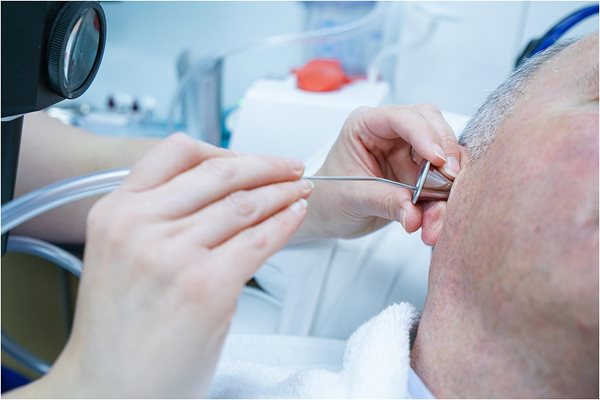
Ear wax, also known as cerumen, is a natural substance produced by the glands in the ear canal. While it serves as a protective barrier for the ear, excessive build up of ear wax can lead to hearing difficulties, discomfort, tinnitus, and other issues. To address this problem, many individuals turn to professional ear wax removal as a solution. In this article, we will explore the process of professional ear wax removal and discuss the factors you should consider when deciding if it is right for you.
Microsuction ear wax removal is a method commonly used by healthcare professionals to remove excess ear wax from the ear canal. This procedure involves the use of specialised tools, such as suction and/or manual instruments for example curettes and forceps, to gently extract the accumulated wax. It is important to note that this technique should only be performed by trained professionals to ensure safety and effectiveness.
Professional ear wax removal via microsuction and/or manual instruments is a precise and targeted approach to eliminate ear wax build up. The healthcare professional carefully examines the ear canal and uses the appropriate instruments to remove the wax. By doing so, they can effectively improve hearing and alleviate discomfort caused by excessive ear wax.
Before deciding if professional ear wax removal is right for you, it is crucial to consider the following factors:
The severity of your ear wax build up plays a significant role in determining the need for ear wax removal. If you are experiencing mild symptoms, such as slightly reduced hearing or occasional discomfort, alternative methods like over the counter ear drops may be sufficient. However, if you have a considerable build up of ear wax that is causing significant hearing difficulties or discomfort, professional removal may be necessary.
Individuals with certain medical conditions, such as a perforated eardrum or chronic ear infections, may not be suitable candidates for some methods of ear wax removal such as irrigation or certain over the counter ear drops. It is essential to consult with a healthcare professional who can evaluate your medical history and overall ear health to determine the most appropriate course of action. They will consider factors such as the health of your eardrum and the presence of any underlying conditions that may affect the procedure’s safety. The safest method of ear wax removal is microsuction and is why at Hearing First we never perform irrigation.
When opting for professional ear wax removal, it is crucial to ensure that the healthcare professional performing the procedure is both experienced and trained in the technique they are using. This will help minimise the risk of complications and ensure a successful removal process. Don’t hesitate to ask about the professional’s qualifications and experience before proceeding with the procedure. A skilled professional will have the expertise to perform the removal safely and effectively.
Like any medical procedure, ear wax removal has its advantages and disadvantages. It is important to weigh these factors before making a decision:
If you are hesitant about microsuction ear wax removal or have specific concerns, there are alternative methods available for ear wax removal. These include:
It is advisable to consult with a healthcare professional to determine the most suitable method for your specific situation. They can evaluate your ear condition, medical history, and any underlying factors to recommend the most appropriate approach.
Assessing which method of ear wax removal is right for you requires careful consideration of multiple factors, including the severity of wax build up, your medical history, pain tolerance, and the expertise of the professional performing the procedure. While microsuction ear wax removal can provide effective results in removing excessive ear wax and improving hearing, it is crucial to weigh the pros and cons and explore alternative methods if necessary. Remember, the primary goal is to ensure the safe removal of excess ear wax and improve your overall ear health.
On many occasions after providing a full hearing assessment I get asked the question “can…
Microsuction is a safe and effective method for removing earwax and debris from the ear…
Ear wax, also known as cerumen, is a substance that is naturally produced by our…
Ear wax, or cerumen, is a natural substance produced by the ear canal to protect…
Cleaning our ears is an important part of our personal hygiene routine. It not only…
Earwax, also known as cerumen, is a natural substance produced by the ear canal to…
This website uses cookies.